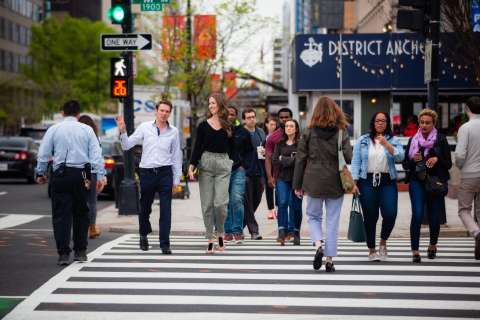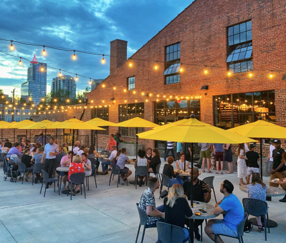Jump To:
Land Use, City Design, and Transportation
This might not seem like an obvious connection. What does land use have to do with transportation emissions? The short answer is: nearly everything. If houses are not close to workplaces, shops, schools, and parks, then trips will take place in cars.
For most of the history of the United States, cities were compact and walkable. However, since World War II, American cities used zoning to require a very spread out form of growth, with homes separated from each other and from everything else. This made driving a necessity for nearly all trips.
There is a growing understanding of how American zoning strategies have led to unanticipated problems such as high greenhouse gas (GHG) emissions. In recent years, Raleigh has taken steps to begin to allow denser housing in places where it is possible to walk to many destinations. This allows vehicle trips to be shorter as well. Continued work in this area will be needed to meet the city’s climate goals. Learn more about the history of land use planning in the United States and how it has contributed to GHG emissions here.
Walkability and Transit
The distance between homes and jobs and shops is a major factor in how we get around. But the facilities and services that help us make those trips is crucial as well. It’s important that our transportation infrastructure makes it possible to get around on foot, bike, scooter, or wheelchair, as well as that our transit system makes it quick and easy to get around by bus. Learn more about sustainable transportation options in Raleigh.
In the past, we built many multilane roads without sidewalks and invested little in transit. Many residential areas and buildings lack any pedestrian connection to nearby shopping centers or offices. But in recent years, Raleigh and Wake County have begun investing significantly in transit, which has led to increased ridership. We also have been creating better facilities to walk or bike and have been making sure driving isn’t the only way to get from point A to point B.
Vehicle Electrification
Creating a more walkable Raleigh will take time. And even in walkable cities, many trips will continue to be made in motor vehicles. Supporting the transition to electric vehicles, then, is an important climate strategy. While electric vehicles still require GHG emissions from power plants, those emissions are substantially less than those produced by gas-powered vehicles.
Raleigh is working both to electrify the city’s 2,000-plus vehicle fleet and to support the community-wide shift to electric vehicles. This work includes adding public charging stations and supporting the development of a network of charging stations across the community.
EVs are a major focus, but other fuel types also reduce emissions compared to traditional fossil fuels. The city has shifted much of its transit and vehicle fleet to run off compressed natural gas, propane, and biofuels (plant-based fuels), all of which provide GHG reduction benefits.
Other Benefits
While reduced GHG emissions are a major benefit of providing more transportation options, that is not the only reason to make it easier to get around without a car. Walking and biking have significant health benefits, with research demonstrating that people who walk frequently gain significant increases in lifespan and health.
Similarly, the same actions that reduce GHG emissions also reduce other forms of air pollution. Cars, even EVs, create air quality issues not just through burning fossil fuels but also from brake and tire dust. These pollutants contribute to asthma and other health issues.
Lastly, while less easy to measure, creating more walkable places enhances social connections. Having the neighborhood coffee shop or pub can foster more interactions between friends and neighbors than the drive-through experience common in less walkable places.
Project Highlight: East Raleigh Park & Ride Lot
The East Raleigh Park & Ride Lot is being designed to expand sustainable transportation access. It will feature EV charging stations and is designed to connect seamlessly with existing transit and greenway networks. This project improves commuter convenience while helping reduce transportation-related emissions.
While walking, biking, or taking the bus are great options, they don’t always get us everywhere we need to go—especially for longer trips or visitors coming from outside Raleigh. Park & ride lots bridge that gap by letting people drive part of the way, then switch to more sustainable transportation for the rest of their journey.




